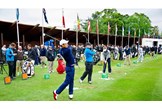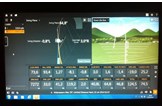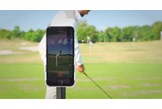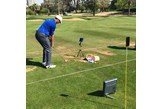It’s about time you went on a launch monitor
Published:
I spend a lot of time at Tour events, both as a Sky Sports pundit, and working with the players I coach. Walking along the practice range, I’ll see players practising and preparing in a variety of different manners. They have different routines, use different swing aids, hit different clubs in different orders and work on different things. One thing they all have in common, however, is the little grey and orange box on the floor behind them.
That box is a launch monitor. Synced with a phone or tablet, it gives the player a wealth of numbers, covering every aspect of the impact of golf club on ball.

Everything that dictates where your ball goes happens at impact, when the clubface makes contact with the ball. The direction the clubhead is travelling and the way it is facing are what determine where the ball goes.
You may well be thinking that this is technology taking over unnecessarily. Hogan, Nicklaus and Palmer didn’t have launch monitors, and they seemed to get on alright. But things have changed. I’m not going to venture into conjecture here about whether they were better than today’s best players, but one thing is certain: we live in an age of advanced technology, where the margins between success and failure are minuscule, and where players will do whatever is possible to eke out the smallest differential.
Impact takes 0.004 seconds. Until launch monitors arrived on the scene, we had no real way of knowing exactly what was happening during that incredibly short amount of time. Now, we can see exact numbers for every measurable of both the clubhead and the ball itself. The truth of impact is in the numbers.
They eliminate a lot of the guesswork that pervaded golf swings for decades. The so-called “ball flight laws” were actually completely false, and did not reflect what actually happened during impact. The cliché “the path sends it and the face bends it” was proven wrong. Launch monitors show that approximately 80% of starting direction is clubface-related. The direction the clubface is pointing and where on the clubface you strike the ball is more important than the club path.

There are two key ways to use this information: club fitting and swing fixing. It’s pretty obvious to me that every golfer, regardless of ability, will benefit from having a club and a ball that best suits them. A launch monitor enables you to have both, with evidence to prove that they are the optimal choices for your game.
From a coaching standpoint, a launch monitor allows the effectiveness of a lesson to be tangibly measured. In the past, the best you could hope for was a general feeling that you were swinging it better and hitting better shots; now you can measure whether the numbers are improving. If so, you can be fairly sure that what you are working on is making you a better golfer, which is very much the idea of a lesson! They also help the coach focus on the right thing, as the truth is never a bad place to start any diagnosis.
There is a danger with launch monitors, however, that the numbers are seen as the holy grail. It is possible to create what I call “fake” numbers by hand-eye coordination and manipulation of the hands through impact. This will give you good numbers on your launch monitor, but will not stand up to the test of time and competition. This is why I would recommend every golfer to go on a launch monitor, but only with a well-informed coach. Left to their own devices with a launch monitor, most amateurs (and even some pros) would do themselves more harm than good!

It is easy to become obsessed with your numbers and forget about learning how to play the game. Your ability to hit solid, predictable golf shots that fit the demands of the situation is what makes scores and ultimately determines your success.
Using launch monitors, we can see what separates top players from the rest of golfers. The best players are very skilled at creating clubhead speed and finding the sweetspot. They have also grooved a consistent angle of attack and path, but even for them, controlling the clubface through impact is the hardest number to make consistent. As you would expect, high handicappers have much less consistency in their numbers, but the primary problem is the failure to consistently find the sweetspot.
On social media, I have noticed that many handicap golfers seem to be wary of launch monitors. I can’t comprehend why. To me, that’s like going on a diet and blaming the bathroom scales if you fail to lose weight. The truth is the best basis for making adjustments. Don’t be afraid of it.




